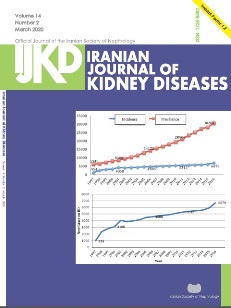Circulating MiR-29a, Possible Use as a Biomarker for Monitoring IgA Nephropathy
Abstract
Introduction. Previous studies have shown that TGF-β1/Smad3 signaling promotes renal fibrosis by inhibiting miR-29. To date, only few studies have reportedon circulating microRNAs in IgA nephropathy (IgAN). However, the plasma expression of miR-29a and its role in patients with IgAN remains unclear. In this study, we attempted to elucidate whether plasma miR-29a expression can be used as a biomarker for monitoring disease states. Methods. For this study, 15 healthy subjects, 36 patients with untreated renal biopsy-proven IgAN, and 79 patients with IgAN, who were under treatment for a period of 1 year on an average, all of whom had similar age and gender distributions, were included. The plasma expression of miR-29a in each group was explored by real-time PCR, and the relationship between miR-29a expression and clinical, pathological, and prognostic indicators of IgAN was further evaluated. Results. Relative plasma expression of miR-29a in patients with IgAN was significantly lower than that in healthy controls (P < .001), and these changes in plasma miR-29a could be suppressed by treatment (P < .05). Plasma miR-29a was positively correlated with eGFR and negatively correlated with proteinuria and serum creatinine, irrespective of whether or not the patients with IgAN accepted treatment (P < .05). Plasma miR-29a level was negatively correlated with primary pathological parameters such as crescent formation, Lee’s and Oxford classification (P < .05). Kaplan–Meier analysis revealed that patients with high plasma expression of miR-29a had better renal function and better response to treatment compared to those with low expression (P < .05). Conclusion. Plasma miR-29a could be considered as a biological marker that reflects renal damage and function, to predict the progression of IgAN.Downloads
Download data is not yet available.
Downloads
Published
2020-03-05
Issue
Section
ORIGINAL | Kidney Diseases
How to Cite
Circulating MiR-29a, Possible Use as a Biomarker for Monitoring IgA Nephropathy. (2020). Iranian Journal of Kidney Diseases, 14(2), 107-118. https://ijkd.org/index.php/ijkd/article/view/4312


